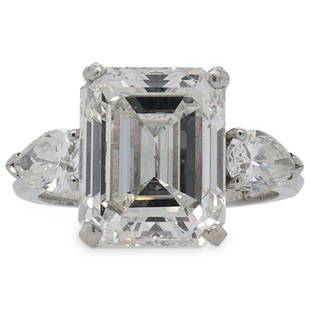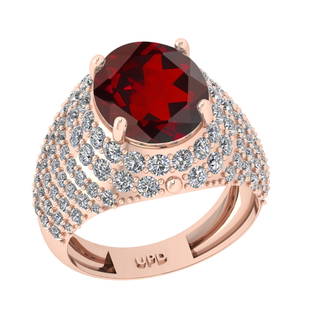Popular Searches
Popular Searches

Garnet Irish Claddah Ring,
Similar Sale History
View More Items in Engagement RingsRelated Engagement Rings
More Items in Engagement Rings
View MoreRecommended Rings
View More





Item Details
Description
wedding ring, 1 carat heart shape gem, 14k yellow gold.....The Claddagh ring (Irish: fáinne Chladaigh) is a traditional Irish ring given as a token of friendship, love, as an engagement ring and as a wedding ring[1][2]. The design and customs associated with it originated in the Irish fishing village of Claddagh, located just outside the city of Galway. The ring as we know it was first produced in the 17th century.
Contents [hide]
1 Symbolism
2 Origins
3 See also
4 Notes
5 References
6 External links
[edit]Symbolism
The Claddagh's distinctive design features two hands clasping a heart, and usually surmounted by a crown. The elements of this symbol are often said to correspond to the qualities of love (the heart), friendship (the hands), and loyalty (the crown). A "Fenian" Claddagh ring, without a crown, is a slightly different take on the design. Claddagh rings, with or without the crown (most commonly with a crown), have come to denote pride in Irish heritage, while continuing to be symbols of love or marriage.
Claddagh rings are often used as friendship rings, but are most commonly used as engagement/wedding rings. In Ireland, America and other places, the Claddagh is handed down mother-to-daughter or grandmother-to-granddaughter. The way a Claddagh ring was worn on the hand was usually intended to convey the wearer's relationship status, according to Irish author Colin Murphy:
On the right hand with the point of the heart toward the fingertips, the wearer is single and may be looking for love. (This is most commonly the case when a young woman has first received the ring from a relative, unless she is already engaged).
On the right hand with the point of the heart toward the wrist, the wearer is in a relationship (suggesting their heart has been "captured").
On the left hand with the point of the heart toward the fingertips, the wearer is engaged.
On the left hand with the point of the heart toward the wrist, the wearer is married.[3]
There are other localised variations in the traditions involving the hand and the finger upon which the Claddagh is worn. Folklore about the ring is relatively recent, not ancient, with "very little native Irish writing about the ring". Hence the difficulty today in finding any source that describes or explains the traditional ways of wearing the ring.[4]
[edit]Origins
The Claddagh ring belongs to a group of European finger rings called "fede rings".[5][6] The name "fede" comes from the Italian phrase mani in fede ("hands [joined] in faith" or "hands [joined] in loyalty"). These rings date from Roman times, when the gesture of clasped hands was a symbol of pledging vows, and they were used as engagement/wedding rings in medieval and Renaissance Europe.[5][7]
Fede rings are cast in the form of two clasped hands, symbolizing faith, trust, or “plighted troth". The Claddagh ring is a variation on the fede ring,[8] while the hands, heart, and crown motif was used in England in the early 18th century.[9]
Galway has produced Claddagh rings continuously since at least 1700,[10] but the name "Claddagh ring" was not used before the 1840s.[6][11]
As an example of a maker: Bartholomew Fallon was a 17th century Irish goldsmith, based in Galway, who made Claddagh rings until circa 1700. His name first appears in the will of one Dominick Martin, also a jeweller, dated 26 January 1676, in which Martin willed Fallon some of his tools. Fallon continued working as a goldsmith until 1700. His are among the oldest surviving examples of the Claddagh Ring, in many cases bearing his signature.[12]
There are many legends about the origins of the ring, particularly concerning Richard Joyce, a silversmith from Galway circa 1700, who is said to have invented the Claddagh design as we know it.[13] His initials are in one of the earliest surviving Claddagh rings[6] but there are three other rings also made around that time, bearing the mark of goldsmith Thomas Meade.[6]
A more mystical legend is also associated with the Joyce family: Margaret Joyce used her inheritance (from her late husband) to build bridges in the province of Connacht, and in 1596 she remarried. She was rewarded for her charity works by an eagle which dropped the Claddagh Ring on her lap.[14]
The Victorian antiquarian Sir William Jones[15] described the Claddagh, and gives Chambers' Book of Days[16] as the source, in his book Finger-Ring Lore. Jones says:
The clasped hands [style ring]... are... still the fashion, and in constant use in [the]... community [of] Claddugh [sic] at [County] Galway.... [They] rarely [intermarry] with others than their own people. The [Claddagh] wedding-ring is a [sic] heirloom in the family... transferred from the mother to the daughter who is first [to be] married, and so passes to her descendants. Many of these [rings]... are very old.
There is a 1906 account by William Dillon[17]. Dillon, a Galway jeweller, claimed that the "Claddagh" ring was worn in the Aran Isles, Connemara and beyond. Knowledge of the ring and its customs spread within the British Isles during the Victorian period, and this is when its name became established.[6] Galway jewellers began to market it beyond the local area in the 19th century,[6][18] More "widespread recognition" came in the 20th century.[8]
American mineralogist and ring expert George Frederick Kunz does not mention the Claddagh ring in the text of his book, but he shows a photo of one, captioned with its correct name. Kunz merely addresses the importance of gold wedding rings in Ireland with absolutely no reference to the Claddagh other than the photo. The true story of the Claddagh ring is too loaded with myth to know what the truth is concerning its origins of design (beyond the Roman fede ring design) or earliest history.[19] It is unclear exactly how and when the ring was brought to the U.S. Interestingly, McCarthy practically fails to address the subject of Irish rings at all.[20]
Today, Claddagh rings are commonly worn, though slightly more commonly by those of Irish heritage. It is generally worn as a cultural symbol and/or as an engagement/wedding ring.[3] Claddagh rings have been used often as plot devices in movies and television.[21][22]
Buyer's Premium
- 15%
Garnet Irish Claddah Ring,
Estimate $100 - $200
2 bidders are watching this item.
Shipping & Pickup Options
Item located in Flat Rock, NC, usSee Policy for Shipping
Payment

TOP












































































